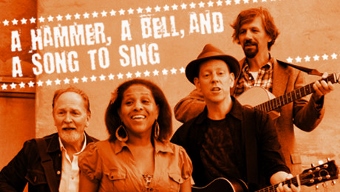A FEW PROTESTS…
Todd Salovey’s revue of mostly American songs of protest is buoyed by a fiercely energetic, multi-talented quartet of singers and musicians: Dave Crossland, Jim Mooney, Vaughn Armstrong, and the redoubtable Lisa Payton. When Payton hits 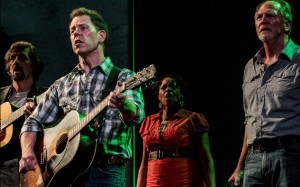 the money notes it’s enough to pop your sternum from its rib cage. But the narrative, the connective tissue that links the songs, is spotty, lacking a cohesive emotional and historical arc.
the money notes it’s enough to pop your sternum from its rib cage. But the narrative, the connective tissue that links the songs, is spotty, lacking a cohesive emotional and historical arc.
That wasn’t its intent. Initially, A Hammer, A Bell and a Song to Sing was to be the story of Pete Seeger and his immense contributions to folk and protest over seven decades. The REP had his blessing and a workshop was set for January of this year. But a few weeks before opening Seeger withdrew his support because, accord to the REP, “… he was no longer comfortable with a play about his life story being produced.”
Salovey and company had to scramble. They pieced together a spectrum of songs that honored the genre, including Seeger and Lee Hay’s “The Hammer Song” from which the title comes. In this new “expanded” version Salovey, who also directs, notes that the script, “… melds significant historical moments with notable music that I and others love.”
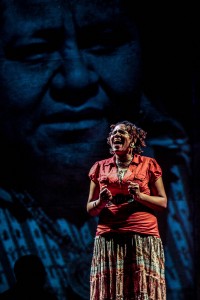 Where those “moments” work best is when the performers recall their own experience. Like when Armstrong and Mooney, a true virtuoso on a variety of chordophones and blessed with a rich vocal bass, regale us with comic and disturbing versions of accepting or avoiding the draft during the Vietnam war. From this context the accompanying songs come to life.
Where those “moments” work best is when the performers recall their own experience. Like when Armstrong and Mooney, a true virtuoso on a variety of chordophones and blessed with a rich vocal bass, regale us with comic and disturbing versions of accepting or avoiding the draft during the Vietnam war. From this context the accompanying songs come to life.
But personal experiences are limited. Most of the selected pieces dangle with inadequate grounding. Sometimes there is not much more than a quote from Martin Luther King or Oscar Wilde or Plato to give context. Selections flit from the Revolutionary War “Johnny Has Gone for a Soldier” to the 13th century English tax protest “Baa Baa Black Sheep” to the long-evolving Cuban anthem “Guantanamera.” Each is worthy of more than an “historical moment” on stage.
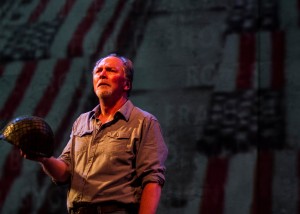 “More” meaning something akin to Salovey’s set-up for Victor Jara’s exquisite “Estadio Chile”: We learn of Jara’s arrest following Pinochet’s coup of the democratically elected Allende government, and the ensuing torture and execution of Jara—along with hundreds of others in the Chile Stadium. Shockingly, no mention is made of the CIA’s role in destabilizing Chile and aiding Pinochet’s junta, but there is enough groundwork to bridge an emotional connection to the music. Clearly, with forty or so songs and excerpts, there simply isn’t time in this 90-minute review to properly develop a satisfying context for each selection.
“More” meaning something akin to Salovey’s set-up for Victor Jara’s exquisite “Estadio Chile”: We learn of Jara’s arrest following Pinochet’s coup of the democratically elected Allende government, and the ensuing torture and execution of Jara—along with hundreds of others in the Chile Stadium. Shockingly, no mention is made of the CIA’s role in destabilizing Chile and aiding Pinochet’s junta, but there is enough groundwork to bridge an emotional connection to the music. Clearly, with forty or so songs and excerpts, there simply isn’t time in this 90-minute review to properly develop a satisfying context for each selection.
Woven through all this is the audience sing-along. At first, it was spirited. Lead by Mr. Crossland, the audience was effortlessly guided through “This Little Light of Mine.” But in subsequent invitations, the crowd’s enthusiasm waned, bottoming out with Woody Guthrie’s “Union Maid” (a few voices in this crowd felt like “sticking to the union”).
We need more than audience participation to give rise to and empower these songs of struggle, but intricate harmonies, beautifully arranged by Musical Director Bruno Louchouran, and evocative “moments-in-history” projections designed by Victoria Petrovich give promise to future renderings of this piece.
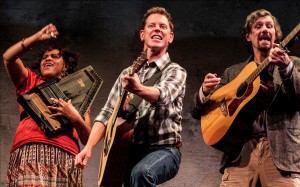 An unintentional but ominous chord is struck. The Occupy movement is referenced many times, including the opening number, which features “The Times They Are A Changing” (1964) against the projected backdrop of Occupy (2011). That’s nearly fifty years apart. OK, movements usually draw from the well of the past. But throughout the evening’s homage, not one song is offered as an example of the current struggle—there are no tunes for Occupy Wall Street. Perhaps A Hammer, A Bell and a Song to Sing is telling us that the era for lifting our voices in protest is over.
An unintentional but ominous chord is struck. The Occupy movement is referenced many times, including the opening number, which features “The Times They Are A Changing” (1964) against the projected backdrop of Occupy (2011). That’s nearly fifty years apart. OK, movements usually draw from the well of the past. But throughout the evening’s homage, not one song is offered as an example of the current struggle—there are no tunes for Occupy Wall Street. Perhaps A Hammer, A Bell and a Song to Sing is telling us that the era for lifting our voices in protest is over.
photos by Daren Scott
A Hammer, A Bell and a Song to Sing
San Diego Repertory Theatre at the Lyceum
scheduled to end on December 2, 2012
for tickets, call phone 619-544-1000 or visit http://www.sdrep.org
